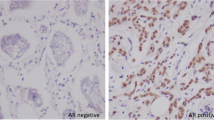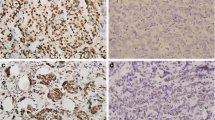Abstract
The estrogen receptor (ER)/progesterone receptor (PR)-negative breast carcinomas (BCs) encompass three molecular subtypes: one with human epidermal growth factor receptor 2 (HER) overexpression, one normal like, and the triple negative. The androgen receptor (AR) is expressed in 70–90% of invasive BCs. The aim of our study is to detect the expression of AR in a series of ER/PR-negative BCs to ascertain if there is clinical significance in relation to BC molecular subtypes. A immunohistochemical study for all receptors and cytokeratin expression was performed in 232 cases of ER/PR-negative BCs. According to cytokeratin expression, BCs were classified into two groups: luminal-type BCs (44.2%) and basal-like-type BCs (55.8%). According to the expression of HER2, 59.3% were triple-negative BCs (when ER, PR, and HER2 were negative) and 40.7% were HER2-positive BCs. AR expression was observed in 128 tumors (56.6%). One hundred and ten cases (48.8%) had >10% and 18 (7.8%) had <10% of positively stained cells. AR immunoreactivity was found in 31.2% basal-like BCs, while in the luminal group 71.1% of cases were positive, showing highly significant correlation (p < 10−8). Regarding HER2 status, 76.7% of HER2-positive BC cases were AR positive compared with only 30.4% of triple-negative BC types, showing a strong statistically significant correlation. In conclusion, we show that AR is frequently expressed in ER/PR-negative BCs and that expression of HER2 and AR is highly correlated (p < 0.005). Our results point out the role of AR and HER2 in the pathogenesis of BCs and suggest the potential role of AR in clinical management of ER/PR-negative BCs.




Similar content being viewed by others
References
Ellis LM, Wittliff JL, Bryant MS et al (1989) Correlation of estrogen, progesterone, and androgen receptors in breast cancer. Am J Surg 157:577–581
Lea OA, Kvinnsland S, Thorsen T et al (1989) Improved measurement of androgen receptors in human breast cancer. Cancer Res 49:7162–7167
Kimura N, Mizokami A, Oonuma T et al (1993) Immunocytochemical localization of androgen receptor with polyclonal antibody in paraffin-embedded human tissue. J Histochem Cytochem 41:671–678
Hall RE, Aspinall JO, Horsfall DJ et al (1996) Expression of the androgen receptor and an androgen-responsive protein, apolipoprotein D, in human breast cancer. Br J Cancer 74:1175–1180
Kuenen-Boumeester V, Van Der Kwast TH, Claassen CC et al (1996) The clinical significance of androgen receptors in breast cancer and their relation to histological and cell biological parameters. Eur J Cancer 32A:1560–1565
Bièche I, Parfait B, Tozlu S et al (2001) Quantitation of androgen receptor gene expression in sporadic breast tumors by real-time RT-PCR: evidence that MYC is an AR-regulated gene. Carcinogenesis 22:1521–1526
Brys M, Wojcik M, Romanowicz-Makowska H et al (2002) Androgen receptor status in female breast cancer: RT-PCR and Western blot studies. J Cancer Res Clin Oncol 128:85–90
Agoff SN, Swanson PE, Linden H et al (2003) Androgen receptor expression in estrogen receptor-negative breast cancer. Immunohistochemical, clinical and prognostic associations. Am J Clin Pathol 120:725–731
Moinfar F, Okcu M, Tsybrovskyy O et al (2003) Androgen receptors frequently are expressed in breast carcinomas. Potential relevance to new therapeutic strategies. Cancer 98:703–711
Riva C, Dainese E, Caprara G et al (2005) Immunohistochemical study of androgen receptors in breast carcinoma. Evidence of their frequent expression in lobular carcinoma. Virchows Arch 447:695–700
Narita D, Raica M, Suciu C et al (2006) Immunohistochemical expression of androgen receptor and prostate-specific antigen in breast cancer. Folia Histochem Cytobiol 44:165–172
Kuenen-Boumeester V, Van Der Kwast TH, Van Putten WLJ et al (1992) Immunohistochemical determination of androgen receptors in relation to oestrogen and progesterone receptors in female breast cancer. Int J Cancer 52:581–584
Soreide JA, Lea OA, Varhaug JE et al (1992) Androgen receptors in operable breast cancer: relation to other steroid hormone receptors, correlation to prognostic factors and predictive value for effect of adjuvant tamoxifen treatment. Eur J Surg Oncol 18:112–118
Isola JJ (1993) Immunohistochemical demonstration of androgen receptor in breast cancer and its relationship to other prognostic factors. J Pathol 170:31–35
Rakha EA, El-Sayed ME, Green AR et al (2007) Breast carcinoma with basal differentiation: a proposal for pathology definition based on basal cytokeratin expression. Histopathology 50:434–438
Bayer-Garner IB, Smoller B (2000) Androgen receptors: a marker of increase sensitivity for identifying breast cancer in skin metastasis of unknown primary site. Mod Pathol 13:119–122
Bryan RM, Mercer RJ, Bennett RC et al (1984) Androgen receptors in breast cancer. Cancer 54:2436–2440
Schippinger W, Regitnig P, Dandachi N et al (2006) Evaluation of the prognostic significance of androgen receptor expression in metastatic breast cancer. Virchows Arch 449:24–30
Perou CM, Sørlie T, Eisen MB et al (2000) Molecular portraits of human breast tumours. Nature 406:747–752
Sørlie T, Perou CM, Tibshirani R et al (2001) Gene expression patterns of breast carcinomas distinguish tumor subclasses with clinical implications. Proc Natl Acad Sci U S A 98:10869–10874
Sørlie T, Tibshirani R, Parker J et al (2003) Repeated observation of breast tumor subtypes in independent gene expression data sets. Proc Natl Acad Sci U S A 100:8418–8423
El-Rehim A, Ball G, Pinder SE et al (2005) High-throughput protein expression analysis using tissue microarray technology of a large well-characterised series identifies biologically distinct classes of breast cancer confirming recent cDNA expression analyses. Int J Cancer 116:340–350
Mattie MD, Benz CC, Bowers J et al (2006) Optimized high-throughput microRNA expression profiling provides novel biomarker assessment of clinical prostate and breast cancer biopsies. Mol Cancer 5:24
Farmer P, Bonnefoi H, Becette V et al (2005) Identification of molecular apocrine breast tumours by microarray analysis. Oncogene 24:4660–4671
Quenel N, Wafflart J, Bonichon F et al (1995) The prognostic value of c-erbB2 in primary breast carcinomas: a study on 942 cases. Breast Cancer Res Treat 35:283–291
Hubbard AL, Doris CP, Thompson AM et al (1994) Critical determination of the frequency of c-erbB-2 amplification in breast cancer. Br J Cancer 70:434–439
Ross JS, Fletcher JA (1999) HER-2/neu (c-erb-B2) gene and protein in breast cancer. Am J Clin Pathol 112:S53–S67
Doane AS, Danso M, Lal P et al (2006) An estrogen receptor-negative breast cancer subset characterized by a hormonally regulated transcriptional program and response to androgen. Oncogene 25:3994–4008
Liegl B, Horn LC, Moinfar F (2005) Androgen receptors are frequently expressed in mammary and extramammary Paget’s disease. Mod Pathol 18:1283–1288
Naderi A, Hughes-Davies L (2008) A functionally significant cross-talk between androgen receptor and ErbB2 pathways in estrogen receptor negative breast cancer. Neoplasia 10:542–548
Rakha EA, El-Sayed ME, Green AR et al (2007) Prognostic markers in triple-negative breast cancer. Cancer 109:25–32
Greene FL, Page DL, Fleming ID et al (2002) The AJCC cancer staging manual, 6th edn. Springer, New York, pp 257–281
Tavassoli FA, Devilee P (2003) Pathology & genetics tumours of the breast and female genital organs. WHO, Albany
Elston CW, Ellis IO (2002) Pathological prognostic factors in breast cancer I The value of histological grade in breast cancer: experience from a large study with long-term follow-up. Histopathology 41(3):151–153, Histopathology 1991;403–410
Laakso M, Loman N, Borg A, Isola J et al (2005) Cytokeratin 5/14-positive breast cancer: true basal phenotype confined to BRCA1 tumors. Mod Pathol 18:1321–1328
Laakso M, Tanner M, Nilsson J et al (2006) Basoluminal carcinoma: a new biologically and prognostically distinct entity between basal and luminal breast cancer. Clin Cancer Res 12:4185–4191
Nahleh Z (2008) Androgen receptor as a target for the treatment of hormone receptor-negative breast cancer: an unchartered territory. Future Oncol 4:15–21
Zaucha R, Sosinska-Mielcarek K, Jassem J (2004) Long-term survival of a patient with primarily chemo-resistant metastatic breast cancer treated with Medroxyprogesterone acetate. Breast 13:321–324
Otani S, Toyota N, Nozaka K et al (2004) Successful combination therapy with 5′-DFUR and MPA for breast cancer with spinal and vertebral metastases. Gan To Kagaku Ryoho 31:2151–2153
Focan C, Beauduin M, Majos F et al (2004) High-dose oral medroxyprogesterone acetate or tamoxifen as adjuvant hormone therapy for node-negative early-stage breast cancer: randomized trial with 7-year update. Clin Breast Cancer 5:136–141
Scawn R, Shousha S (2002) Morphologic spectrum of estrogen receptor-negative breast carcinoma. Arch Pathol Lab Med 126:325–330
Putti TC, El-Rehim DM, Rakha EA et al (2005) Estrogen receptor-negative breast carcinomas: a review of morphology and immunophenotypical analysis. Mod Pathol 18:26–35
Allred DC, Harvey JM, Berardo M et al (1998) Prognostic and predictive factors in breast cancer by immunohistochemical analysis. Mod Pathol 11:155–168
Yeh S, Lin HK, Kang HY et al (1999) From HER/Neu signal cascade to androgen receptor and its coactivators: a novel pathway by induction of androgen target genes through MAP kinase in prostate cancer cells. Proc Natl Acad Sci U S A 96:5458–5463
Meng TC, Lee MS, Lin MF (2000) Interaction between protein tyrosine phosphatase and protein tyrosine kinase is involved in androgen-promoted growth of human prostate cancer cells. Oncogene 19:2664–2677
Liu Y, Majumder S, McCall W et al (2005) Inhibition of HER-2/neu kinase impairs androgen receptor recruitment to the androgen responsive enhancer. Cancer Res 65:3404–3409
Guo Z, Dai B, Jiang T et al (2006) Regulation of androgen receptor activity by tyrosine phosphorylation. Cancer Cell 66(10):309–319
Mellinghoff IK, Vivanco I, Kwon A et al (2004) HER2/neu kinase-dependent modulation of androgen receptor function through effects on DNA binding and stability. Cancer Cell 6:517–527
Shao D, Lazar MA (1999) Modulating nuclear receptor function: may the phos be with you. J Clin Invest 103:1617–1618
Niemeier LA, Dabbs DJ, Beriwal S et al (2010) Androgen receptor in breast cancer: expression in estrogen receptor-positive tumors and in estrogen receptor-negative tumors with apocrine differentiation. Mod Pathol 23:205–212
Park S, Koo J, Park HS et al (2010) Expression of androgen receptors in primary breast cancer. Ann Oncol 21:488–492
Jones C, Nonni AV, Fulford L et al (2001) CGH analysis of ductal carcinoma of the breast with basaloid/myoepithelial cell differentiation. Br J Cancer 85:422–427
Nielsen TO, Hsu FD, Jensen K et al (2004) Immunohistochemical and clinical characterization of the basal-like subtype of invasive breast carcinoma. Clin Cancer Res 10:5367–5374
Rakha EA, Putti TC, Abd El-Rehim DM et al (2006) Morphological and immunophenotypic analysis of breast carcinomas with basal and myoepithelial differentiation. J Pathol 208:495–506
Moe RE, Anderson BO (2007) Androgens and androgen receptors: a clinically neglected sector in breast cancer biology. J Surg Ong 95:437–439
Conflict of interest statement
We declare that we have no conflict of interest.
Author information
Authors and Affiliations
Corresponding author
Additional information
Research support
This study has been in part supported by a grant from the University of Insubria, Varese, Italy.
Rights and permissions
About this article
Cite this article
Micello, D., Marando, A., Sahnane, N. et al. Androgen receptor is frequently expressed in HER2-positive, ER/PR-negative breast cancers. Virchows Arch 457, 467–476 (2010). https://doi.org/10.1007/s00428-010-0964-y
Received:
Revised:
Accepted:
Published:
Issue Date:
DOI: https://doi.org/10.1007/s00428-010-0964-y




